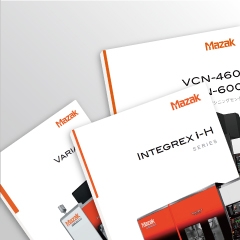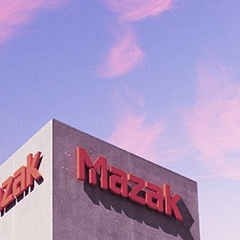Get to Know Your Spindle’s True Capabilities
Some shops lack a true understanding of machine tool spindle specifications. While comprehending spindle speed ratings are cut and dry because they are represented in rpm, the situation gets a bit muddled when it comes to spindle horsepower (HP) and torque specifications. It for this reason that shops must familiarize themselves with the various ways machine tool OEMs list/represent those spindle specifications and how they translate into a spindle’s true capabilities.
Only time will tell
The spindle decision-making process typically starts with a shop’s intended part applications and the appropriate spindle speed. From there, spindle speed, HP and torque requirements are determined. However, machine tool OEMs often measure and/or present those HP and torque ratings differently.
When it comes to spindle HP and torque, shops need to ask whether the machine’s HP is continuous or duty rated. Machine tool OEMs like Mazak, for instance, will list both a spindle’s continuous and duty rated HP in the form of ED that is related to heat. Heat will diminish a spindle’s HP over time.
ED represents HP based on a 10 minute cycle, while others may base it on a five- or 30-minute cycle. To illustrate, a 10% ED means 10% of ten minutes, which equates to one minute the spindle can safely run heat-wise at full HP and torque. For the other nine minutes, the spindle would be at no load to maintain the duty cycle without overtaxing the spindle. In essence, duty cycle means that while a spindle is running, it may only be doing so at a percentage of its full HP rating.
Torque and HP charts tell all
To ensure shops fully understand a spindle’s capabilities, they should ask to see a machine’s torque and HP chart. The torque and HP curve on these charts will indicate the spindle’s available full HP and torque and answer the essential questions of what’s the HP, how long can it be maintained, is it continuous and is it duty rated. Also, a spindle’s design will dictate the torque and HP curve direction.
Torque and HP are related and affected by cutting loads on a spindle. Torque is listed with the same specifications as with HP ratings, meaning the same criteria for HP applies to a spindle’s torque rating – duty cycle, continuous, etc. When a shop overruns a spindle, they’re exceeding its available torque, and the electronics inside the spindle will warn of potential damage and shut off the spindle because machines have spindle load meters that are set to a specific torque level.
Because torque and HP have a converse relationship, a higher rpm/HP spindle usually means sacrificing torque and vice versa. A key point to remember is that a spindle will achieve its true torque at a certain rpm, and as that speed is increased, the torque level will begin to drop.
While shops could simply run at slower spindle speeds to always get max torque, the part they are cutting may not allow them to do so. Yes, they could take heavy cuts at lower spindle speeds, but the machine’s maximum torque continuous rating may be for only 10 minutes.
Buyer beware
Some OEMs will list a spindle’s maximum HP, but they fail to provide an ED or continuous rating and will instead give a percentage statement, like “based on 200% load” on the torque and HP chart. This means if a shop runs the spindle at 200% of the machine’s load meter, that’s where it will get the spindle’s full HP. Unfortunately, there is no indication as to how long those rates can be maintained before overtaxing the spindle.
Such percentage ratings are often vague because shops aren’t going to run a spindle at 200% load. Yes, shops can and do exceed spindle load meters but only for extremely short periods of time. If a shop is consistently exceeding spindle load levels, they should consider a machine with a more powerful spindle in terms of HP and torque.
Acceleration/deceleration
A machine tool spindle’s acceleration/deceleration (Acc/Dec) duty cycle is how fast a machine reaches its maximum rpm, then once it’s there, how quickly it can stop. The importance of a machine spindle’s Acc/Dec speed depends on the intended application.
Consider a shop that’s running automotive type parts where the machining processes start and stop often – milling, then drilling, then tapping. In those instances, there will be a lot of tool changes, which makes the Acc/Dec time important because if it’s too long it adds to cycle time.
At the other end of the spectrum, consider a shop hogging out an aerospace part from an aluminum billet or machining nickel alloy parts. In those instances, Acc/Dec won’t be that critical because the machine is in the cut for longer periods of time, so a one- or two-second Acc/Dec time is inconsequential and represents a miniscule number in the overall part cycle time.
Shops need to consider Acc/Dec times in unison with a spindle’s duty cycle. This is because every time a spindle ramps up to full rpm then back down to zero for a tool change, it generates heat. If the duty cycle time span isn’t long enough for the spindle to cool, it will shut down automatically.
Another factor to keep in mind concerning Acc/Dec is HP. While a machine may have high HP, a good portion of it is needed to ramp up to maximum spindle speed. Thus making that amount unavailable for high-HP cutting.
The selection of a spindle’s speed, HP, torque and Acc/Dec starts with a shop’s part applications along with obtaining the torque and HP chart and consulting the machine’s OEM. In doing so, shops gain a true picture of a spindle’s full potential and can confidently select the best spindle for their needs.

ABOUT MAZAK CORPORATION
Mazak Corporation is a leader in the design and manufacture of productive machine tool solutions. Committed to being a partner to customers with innovative technology, its world-class facility in Florence, Kentucky produces over 70 models of turning centers, Multi-Tasking machines and vertical machining centers, including 5-axis models, Hybrid Additive processing machines and Swiss Turning Machines. Continuously investing in manufacturing technology allows the Mazak iSMART Factory™ to be the most advanced and efficient in the industry, providing high-quality and reliable products. Mazak maintains eight Technology Centers across North America to provide local hands-on applications, service and sales support to customers.





